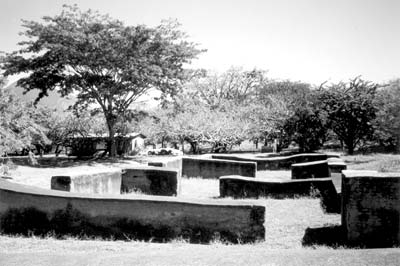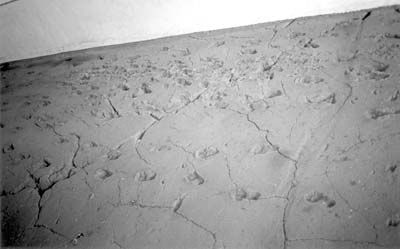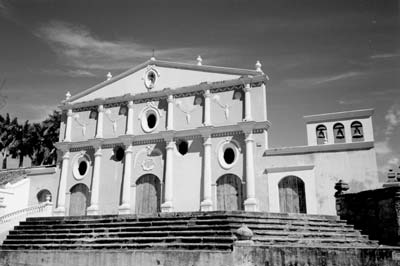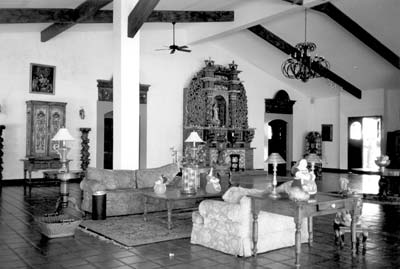Nicaraguan archaeological gems
by Julie Skurdenis
Nicaragua, wedged between Honduras to the north and Costa Rica to the south and with both an Atlantic and a Pacific coast, was a serendipitous discovery. I’m always on the prowl for archaeological sites and artifacts. Nicaragua did not disappoint in its variety: a rediscovered colonial-era settlement which was the country’s first capital; 6,000-year-old footprints, and black basalt statues carved over a thousand years ago.
But it was the physical beauty of this country — with numerous active and inactive volcanoes and two vast freshwater lakes, the colonial towns of León and Granada, the craft villages clustered in the highlands outside Managua, the extraordinary hotels we slept in and the wonderful restaurants we dined in — that turned our January 2005 trip into more than my husband, Paul, and I had expected. The archaeology was the icing on our cake.
Ruins of León Viejo
Our trip centered on three cities strung along the Pacific side of Nicaragua: León, Managua and Granada.
León, the first we visited, will be celebrating its 400th anniversary in 2010. But it was the even older colonial city of León Viejo (Old León), founded in 1524 by Francisco Hernandez de Cordoba, that we had come to see.
Located 18 miles southeast of León at the edge of Lago de Managua, one of two enormous Nicaraguan lakes, and close to Momotombo Volcano, León Viejo was destroyed over a 30-year period (1580 to 1610) by earthquakes and volcanic eruptions. It was finally abandoned in 1610 and all but forgotten.
It was rediscovered in 1931, and excavations did not begin until 1967, when the foundations of a treasury/mint, two churches, a large plaza, homes and even a “house of ill repute” emerged from almost four centuries under volcanic ash.
In 2000, the bones of Nicaragua’s founder, de Cordoba, were found in La Merced, one of the churches excavated. They were lying beside the bones of Pedrarias Davila, the first governor of Nicaragua, who executed de Cordoba in 1526.
Still awaiting excavation is León Viejo’s fortress, covered by a large earth mound. Visitors can climb the mound for a panoramic view of the lake, the volcano and the excavated ruins of León Viejo. León Viejo was declared a UNESCO World Heritage Site in 2000.
As for the newer León, don’t miss its Cathedral, one of the most impressive in Central America; the streets lined with old colonial-era houses, with many walls bearing political murals, and the home (now a museum) of Ruben Dario, Nicaragua’s foremost poet (1867-1916).
Also, don’t miss staying at the elegant Hotel El Convento, once part of the adjacent 17th-century Church of San Francisco. Built around a lovely garden with a central fountain, the hotel is full of antiques and colonial charm and boasts an excellent restaurant.
Footprints from the past
Managua, much of it devastated by an earthquake in 1972, is Nicaragua’s capital and the site of a fascinating small museum, Museo Las Huellas de Acahualinca (The Footprints of Acahualinca Museum).
In 1874, a series of footprints was found in volcanic mud that had solidified, preserving them perfectly. Archaeologists speculate that a small band of men, women and children walked across the soft mud 6,000 years ago, perhaps on their way to the nearby lake. Their footprints were covered over by ash soon afterward, encasing them.
The prints are located exactly where they were found, 12 feet below the present ground level, under minimal protection from the elements. Mingled with the human footprints are prints made by animals, including deer and birds.
In Managua, don’t miss visiting the National Museum, housed in the National Palace of Culture with cool courtyards and large murals; the ruins of the beautiful old Cathedral, another victim of the 1972 earthquake; the controversial new Cathedral, a box-like concrete structure topped with numerous mosque-like domes, and the art galleries scattered around the city.
Also, don’t miss staying at the elegant new InterContinental Metrocenter Hotel, with a lovely small pool and the best dinner buffets (a different theme each night) in Nicaragua.
Pre-Columbian statues
Highest on my archaeological list were the pre-Columbian Zapatera statues displayed in what was once the cloister of the Church of San Francisco in Granada. These were discovered in 1849 by Ephraim George Squier, an American archaeologist/journalist/diplomat, on Zapatera Island in Lago de Nicaragua, the second-largest of Nicaragua’s enormous lakes.
Carved from black basalt between A.D. 800 and 1200, the 27 statues on exhibit stand four to seven feet tall and represent humans or animals. Most are combinations of human and animal — an animal atop the head or shoulders of a human as well as merged human-animal figures with the animal seeming to emerge from the human figure or vice versa. The animals represented include the jaguar, monkey, serpent, lizard and turtle. They may be the protectors or guardians of the humans, but no one knows for sure. This superb collection is a “must see.”
In Granada, don’t miss the Cathedral beside the Parque Central and the streets lined with old colonial houses, many painted in pastel colors with ornate doorways and beautiful work of wrought iron.
Also not to be missed between the cities of Managua and Granada, only 50 miles apart, are the villages specializing in crafts, especially San Juan de Oriente for its spectacular, inexpensive ceramics (take your own bubble wrap or tissue paper if you’re interested in buying; none is supplied). There are other villages nearby which specialize in hammocks, masks, sweets, wicker rocking chairs (oh, how I wanted to take home one of these) and even marimbas.
Don’t miss staying at Hotel Colonial, steps away from the lively Parque Central. It has rooms in Spanish colonial style and a picturesque small pool enclosed within lush greenery and bougainvillea.
If you go. . .
Our 8-day trip to Nicaragua was perfectly and minutely planned by Latin American Escapes, which arranged flights, hotels, some meals and a private tour with guide and driver. We were very fortunate to have as our guide Richard Leonardi, the knowledgeable and enthusiastic author of the excellent “Nicaragua Handbook” (2001, Footprint Handbooks, Bath, England. ISBN 1-903471-14-1).
The cost of the customized trip, without airfare, was approximately $2,500 for two of us. We had combined Panama (which I’ll cover in a future issue of ITN) with Nicaragua, flying from New York to Panama City, Panama City to Managua and Managua to New York.
The cost of the flights via American Airlines from New York to Panama and from Managua to New York was $654 each. It cost an additional $289 each for the 1_-hour one-way flight on Copa Airlines between Panama City and Managua. American Airlines does not have flights between Panama City and Managua.
Latin American Escapes (PMB #421/712 Bancroft Ave., Walnut Creek, CA 94598; phone 800/510-5999, fax 530/879-9290, e-mail travel@latinamericanescapes.com or visit www.latinamericanescapes.com), with whom we’ve traveled previously to Chile and Bolivia, covers destinations throughout South and Central America, including the Galápagos, Patagonia, the Amazon and Peru. LAE offers adventure trips, natural history trips and cultural tours. There are group departures as well as customized trips similar to our Nicaraguan trip.





